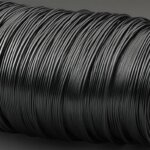Table of Contents
Optical fiber technology has revolutionized modern communication systems by enabling high-speed data transmission over long distances with minimal loss. Optical fiber refers to a thin, flexible strand made of glass or plastic, which carries digital information in the form of light pulses.
The core of the optical fiber transmits a light signal, while the cladding layer that surrounds it serves to reflect all light back into the core using the principle of total internal reflection. Given its unique ability to transmit light over long distances, optical fiber technology has become a vital component of the internet and telecommunication networks.
Key Takeaways
- Optical fiber technology is a critical component of modern communication systems.
- It enables high-speed data transmission with minimal loss.
- Optical fiber works by transmitting data in the form of light signals through the core of the fiber.
- The cladding layer serves to reflect all light back into the core.
- Optical fiber technology is widely used in telecommunications and data centers.
Understanding Optical Fiber: The Basics
Optical fiber is a technology that transmits data as light signals through a clear, flexible strand of glass or plastic called the optical fiber. It is a crucial component of modern communication systems, allowing high-speed data transmission with minimal loss.
The optical fiber consists of two main components: the core and cladding. The core is a glass or plastic strand that carries the light signals, while the cladding is a protective layer that surrounds the core to keep the light signals inside.
The light signals transmitted through the core of the optical fiber travel by total internal reflection. This phenomenon occurs when the light signals are reflected back towards the core due to the difference in refractive index between the core and cladding, resulting in efficient transmission of light signals within the core.
Optical Fiber Applications and Advantages
Optical fiber technology has revolutionized the way we communicate and share information. Its applications are vast and varied, enabling high-speed internet connections, telecommunications networks, and data centers.
High-Speed Internet
Optical fibers have proven to be an essential technology for providing high-speed internet connections. Its high bandwidth capacity allows for faster and more reliable internet connections, making it an ideal choice for businesses and households.
Fiber-to-the-Home (FTTH) is a popular deployment method, offering homeowners an ultra-fast broadband connection with minimal lag. It is becoming increasingly popular in urban areas, where high-speed connectivity is in high demand.
Telecommunications
Optical fibers are also crucial for telecommunications networks, enabling the efficient transmission of data over long distances. Its minimal loss capabilities ensure that signals remain strong and clear, even over thousands of miles.
Fiber-optic networks are ideal for carrying large amounts of data over long distances, making them the technology of choice for international communications. It has played an instrumental role in connecting businesses and individuals across the globe, enabling seamless communication and collaboration.
Data Centers
Optical fibers are the perfect choice for data centers that require high-speed data transmission and storage. Its high bandwidth capacity and immunity to electromagnetic interference make it an ideal technology for large-scale compute and storage facilities.
Additionally, optical fibers enable data centers to be located further apart, improving disaster recovery and increasing redundancy. It ensures that data is always backed up and available, making it an essential technology for businesses of all sizes.
Advantages of Optical Fiber
“Optical fibers have a myriad of advantages over traditional copper wires, including its high bandwidth capacity, minimal signal loss, and resistance to electromagnetic interference.”
- Immunity to Electromagnetic Interference: Optical fibers are immune to electromagnetic interference, making them an ideal choice for areas with high levels of electromagnetic activity or interference.
- High Bandwidth Capacity: It can carry more data over a longer distance, making it an ideal technology for high-speed internet, telecommunications, and data centers.
- Minimal Signal Loss: Optical fibers have minimal signal loss over long distances, making them an essential technology for long-distance communication and storage.
- Resistance to Corrosion: Optical fibers are resistant to corrosion and other environmental factors, allowing them to be used in a variety of environments and applications.
In conclusion, optical fiber technology has revolutionized modern communication systems. Its applications in high-speed internet, telecommunications, and data centers have transformed the way we share information and connect with others. The advantages of optical fibers over traditional copper wires are numerous, making it an essential technology for businesses and individuals alike.
Conclusion
In conclusion, optical fiber technology has revolutionized modern communication systems by enabling high-speed data transmission over long distances with minimal loss. As discussed in this article, optical fiber works by transmitting data in the form of light signals through a clear, flexible strand. Its key components, including the core and cladding, allow for efficient transmission of light signals within the core through total internal reflection.
Optical fiber plays a pivotal role in enabling high-speed internet connections, telecommunications networks, and data centers. Its advantages, such as immunity to electromagnetic interference, high bandwidth capacity, and long-distance transmission capabilities make it a superior choice to traditional methods of data transmission.
Overall, optical fiber continues to revolutionize the way we connect and share information, highlighting its importance in modern communication. As we progress towards a more digitally inclined world, optical fiber remains a crucial component in enabling high-speed data transmission for various applications.
FAQ
What is optical fiber technology?
Optical fiber technology is a method of transmitting data using thin strands of glass or plastic called optical fibers. It revolutionizes modern communication systems by allowing high-speed data transmission with minimal loss.
How does optical fiber work?
Optical fiber works by transmitting data in the form of light signals through a clear, flexible strand called the optical fiber. The core of the fiber guides the light signals, while the cladding helps contain the light within the core through total internal reflection.
What are the applications of optical fiber technology?
Optical fiber technology has various applications, including providing high-speed internet connections, establishing telecommunications networks, and supporting data centers. Its advantages, such as immunity to electromagnetic interference and high bandwidth capacity, make it ideal for these purposes.
What are the advantages of optical fiber technology?
Optical fiber technology offers several advantages. It provides high bandwidth capacity, enabling faster data transmission. It is also immune to electromagnetic interference, ensuring a reliable connection. Optical fiber can transmit signals over long distances without significant loss, making it ideal for long-distance communication.
Why is optical fiber technology important in modern communication?
Optical fiber technology is vital in modern communication due to its ability to facilitate high-speed data transmission. It enables us to transmit large amounts of information quickly and efficiently, contributing to the development of advanced communication systems and supporting the increasing demand for faster and more reliable connections.







